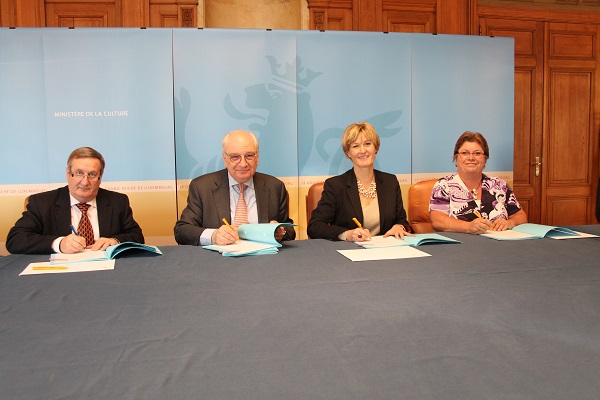 (L-R): Antoine Rodesch, Mayor of Rambrouch; Guy Arendt, Secretary of State for Culture; Francine Closener, Secretary of State for the Economy; Agnes Hoogenhout, President of Les Amis de l’Ardoise a.s.b.l.;
Credit: MCULT
(L-R): Antoine Rodesch, Mayor of Rambrouch; Guy Arendt, Secretary of State for Culture; Francine Closener, Secretary of State for the Economy; Agnes Hoogenhout, President of Les Amis de l’Ardoise a.s.b.l.;
Credit: MCULT
Luxembourg's Ministry of Culture and Ministry of Economy have announced that a new management body has been appointed to the former slate quarries at Haut-Martelange, located just the Luxembourg side of the border with Belgium.
In an effort to upgrade the old slate quarries of Haut-Martelange and following the government's decision to make part of the galleries accessible for educational and tourist purposes, an association has been created to manage the site and monitor the restoration work.
The statutes of the "Musée de l'Ardoise asbl" association were signed on 4 December 2018 by the Secretary of State for the Economy, Francine Closener, the Secretary of State for Culture, Guy Arendt, as well as the mayor of the municipality of Rambrouch, Antoine Rodesch, and the president of "Les Amis de l'Ardoise asbl", Agnes Hoogenhout.
The new association brings together representatives of the Ministry of Culture, the Ministry of Economy (DG Tourism), the municipality of Rambrouch and "Friends of Ardoise asbl" of which the purpose is the educational and tourism exploitation of the old slate quarries. The Ministry of Economy will enter into an agreement with the new association to cover operating costs, while the Ministry of Culture is in charge of the rehabilitation of the underground chambers of the old slate quarries of Haut-Martelange, with the Service des Sites et Monuments National listed as the owner.
Secretaries of State Closener and Guy Arendt have welcomed this new phase in the preservation of this 8-hectares site which comprises various inter-linked components of the slate industry: underground mines, industrial buildings, administrative buildings and housing, in addition to rail transport.
Unique throughout Europe, the site is distinguished above all by its underground mines with a depth of up to 168 metres. These are currently flooded by the water table and rainwater, with plans to make accessible the old extraction chambers to a depth of 42 metres.








